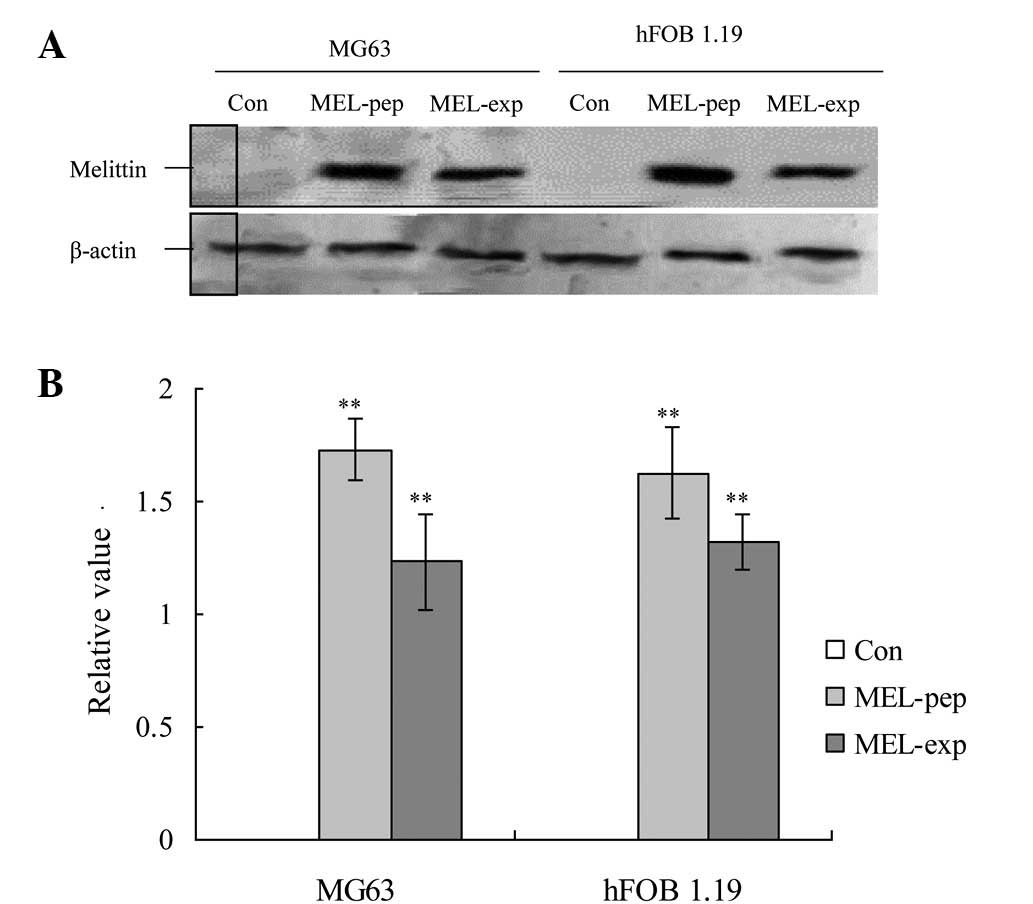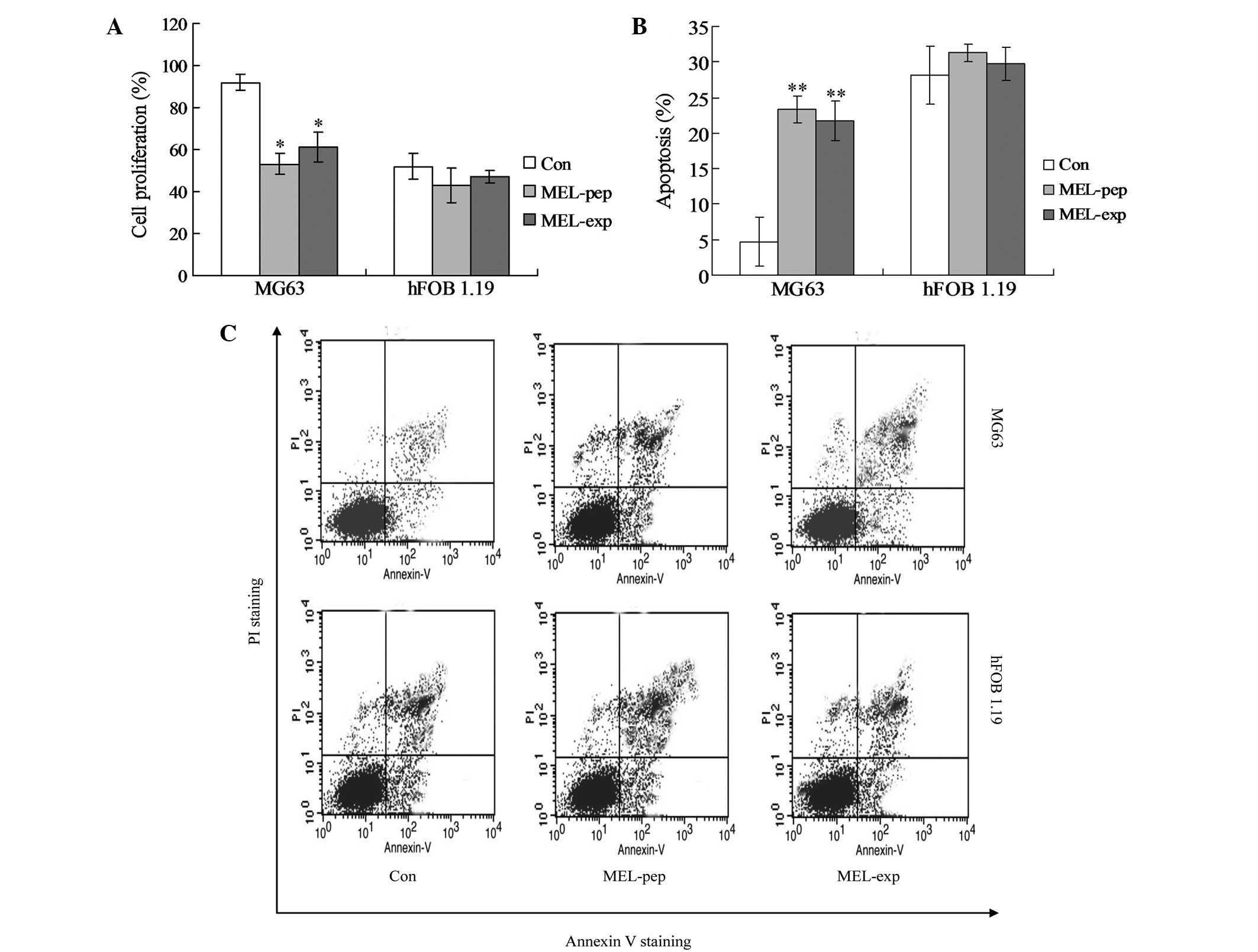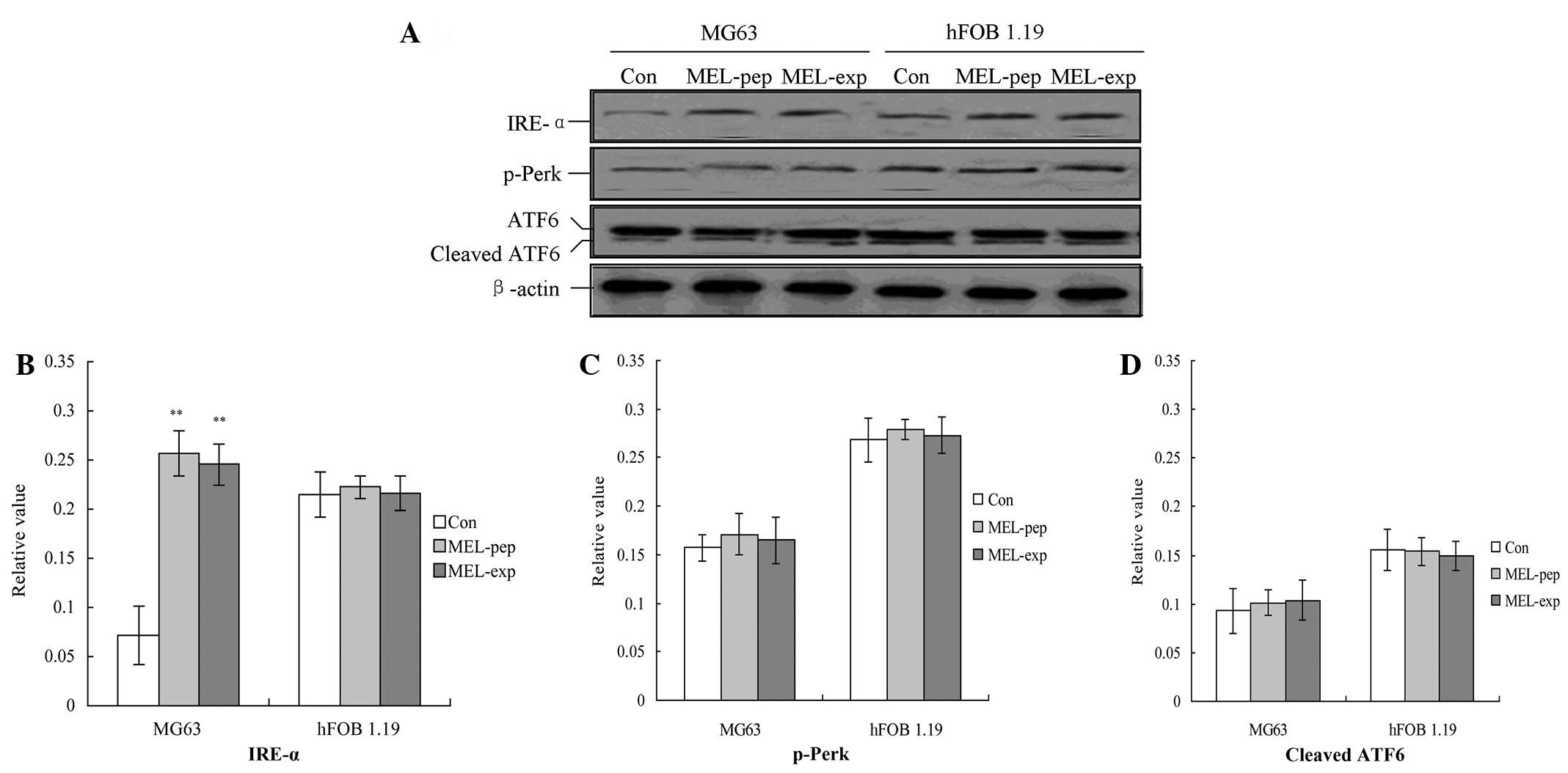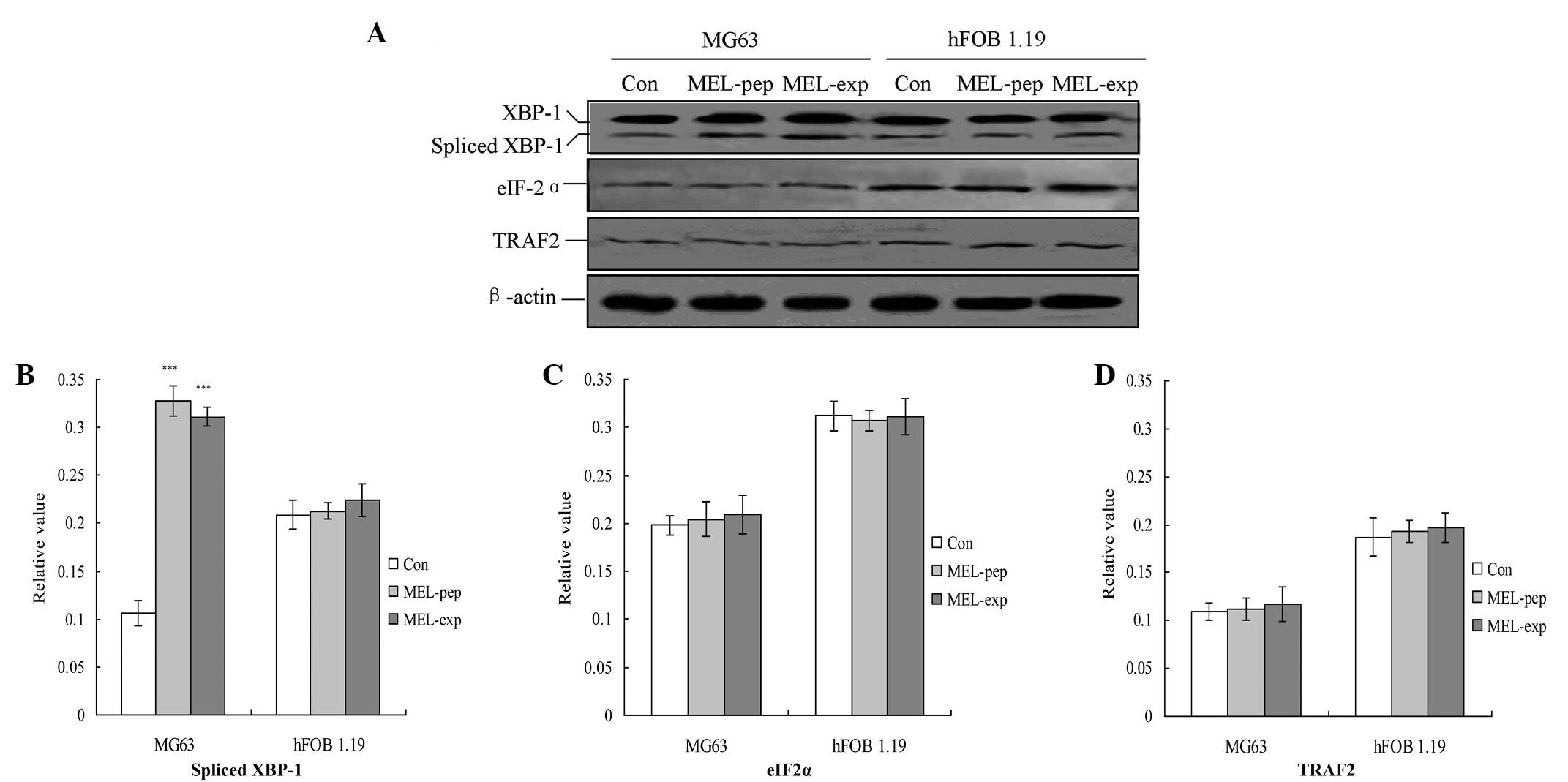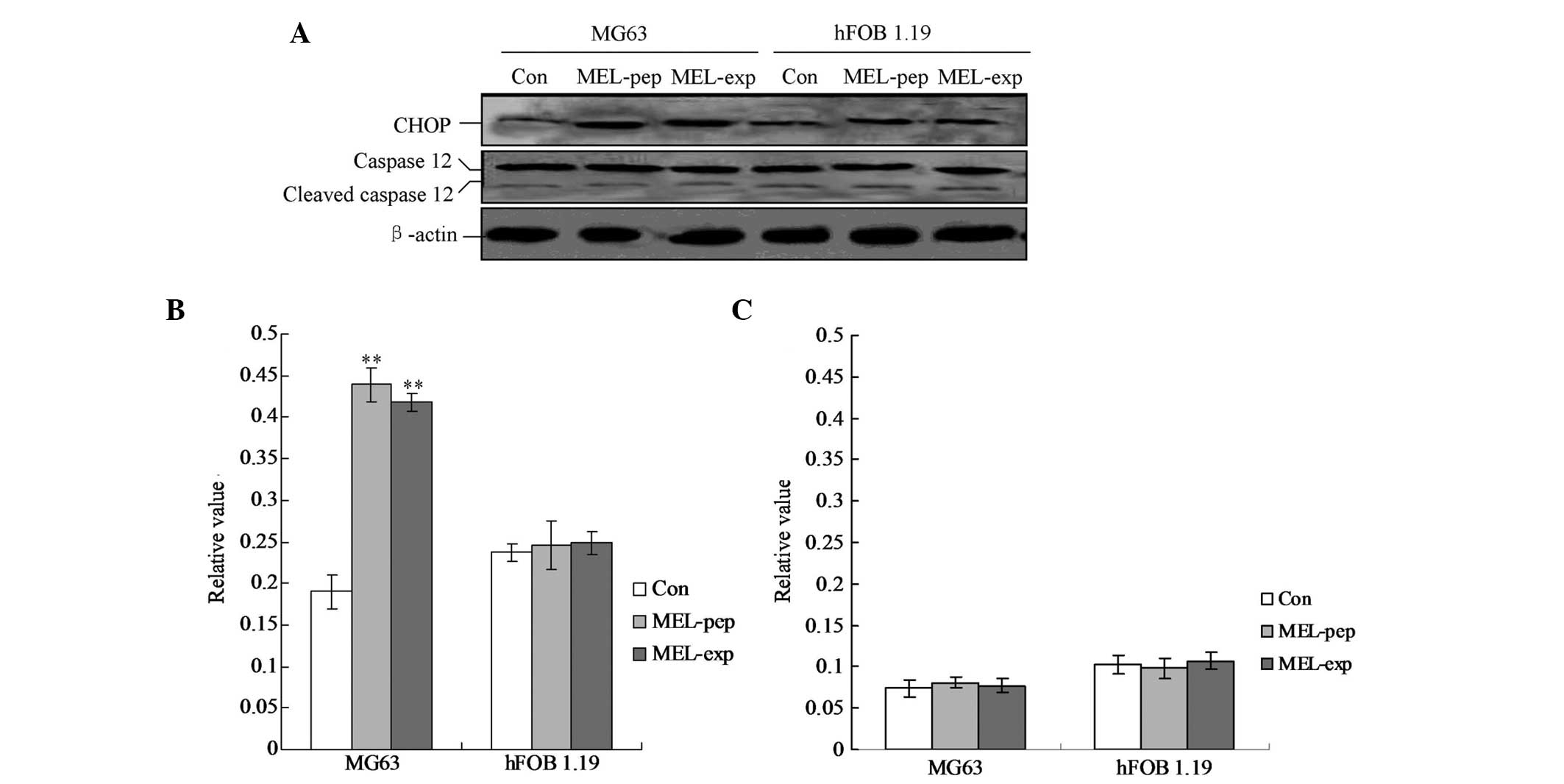Melittin protein inhibits the proliferation of MG63 cells by activating inositol‑requiring protein‑1α and X‑box binding protein 1‑mediated apoptosis
- Authors:
- Published online on: February 7, 2014 https://doi.org/10.3892/mmr.2014.1936
- Pages: 1365-1370
Abstract
Introduction
Bee venom (BV) has been used as a non-steroidal anti-inflammatory drug for the treatment of inflammatory diseases for a number of years (1,2). Hong et al (3) demonstrated that BV was able to induce apoptosis through caspase-3 activation in synovial fibroblasts. Jang et al (4) reported that BV also triggered apoptosis through inhibiting cyclooxygenase (Cox)-2 expression in human lung cancer cells. Moon et al (5) identified that the key regulators in BV-induced apoptosis were B-cell lymphoma 2 (Bcl-2) and caspase-3 in human leukemic cells through the downregulation of mitogen-activated signal pathways. There are several biologically active peptides in BV extracts, including melittin (MEL), a major component, apamin, phospholipase A2 (PLA2), adolapin and mast cell degranulating peptide (6).
In recent years, a number of studies have reported that the MEL may also induce apoptosis, and with even higher activities. Son et al (7) demonstrated that MEL induces apoptosis in vascular smooth muscle cells through the suppression of NF-κB and Akt activation. However, Shaposhnikova et al (8) reported that MEL may activate PLA2 in tymocytes and cause necrosis, but not apoptosis. Kim et al (9) proved that MEL may regulate mitochondrial apoptosis-associated gene expression to induce apoptosis in rheumatoid arthritis. Although a number of studies have illustrated that MEL has significant anti-proliferative and pro-apoptotic effects, the specific mechanisms of MEL remain elusive in human osteosarcoma cells.
A novel pathway of apoptosis due to endoplasmic reticulum (ER) stress has been identified recently (10). In endoplasmic reticulum stress, the adaptive responses of cells are referred to as the unfolded protein response (UPR). Phosphorylated-protein kinase R (PKR)-like ER kinase (p-Perk), inositol-requiring protein-1 and activating transcription factor 6a (ATF6a) are key transmembrane signaling proteins involved in UPR (11).
In the present study, an attempt is made to explore the pro-apoptotic effect and the specific mechanism of MEL in human osteosarcoma cells.
Materials and methods
Plasmid construction
Amplification of the MEL gene was performed by polymerase chain reaction (PCR) using the cDNA of BV extracts, with the following primers: Forward, 5′-CGTGGATCC GGAATTGGAGCAGTTCTC-3′ and reverse, 5′-AGTCTC GAGCGCCTTTGAGTGAGCT-3′. The PCR product was ligated to vector pMD18-T, and subcloned into vector pcDNA3.1(+), yielding a recombinant plasmid, pcDNA3.1-LPT. Amplification was performed in a programmable thermal controller (Thermo-Hybaid, Hybaid Limited, Cambridge, UK) with one cycle of 94°C for 3 min followed by 30 cycles of denaturation at 94°C for 90 sec, annealing at 63°C for 60 sec, followed by extension at 94°C for 60 sec and a final step of 72°C for 10 min.
Cell lines, culture and transfection
The human osteosarcoma cell line MG63 and the human fetal-osteoblast cell line hFOB 1.19 were obtained from the American Type Culture Collection (CRL-6253; Manassas, VA, USA) and cultured in Dulbecco’s modified Eagle medium supplemented with 10% heat-inactivated fetal bovine serum, 100 U/ml penicillin and 100 μg/ml streptomycin. All the cells were cultured at 37°C with 5% CO2. The MG63 and hFOB 1.19 cells were plated into 6 or 96-well plates (Falcon, Osaka, Japan) 24 h prior to transfection. The plasmids were transfected into MG63 and hFOB 1.19 monolayer cells with Lipofectamine™ 2000 transfection reagent (Invitrogen Life Technologies, Carlsbad, CA, USA; employed as the MEL-exp group). The MG63 and hFOB 1.19 cells were harvested by trypsin/EDTA in PBS 24 h following transfection. The cells were then pelleted by a short centrifugation (5,000 × g), suspended in the lysis buffer as previously described by Wang et al (12) and supplemented with a complete proteasomal inhibitor mixture (Merck KGaA, Darmstadt, Germany).
Western blot analysis
The cell lysates were separated by 15% SDS-PAGE and electro-transferred onto nitrocellulose membranes. Following blocking with 5% skimmed milk in phosphate-buffered saline overnight at 4°C, the membranes were then incubated with 1:1,000 MEL-specific monoclonal antibody (mAb; Santa Cruz Biotechnology, Inc., Santa Cruz, CA, USA), 1:1,000 goat anti-human CHOP polyclonal antibody (pAb), 1:3,000 mouse anti-human p-Perk mAb, 1:3,000 mouse anti-human inositol-requiring protein-1α (IRE-α) mAb, 1:600 anti-human β-actin mAb (Santa Cruz Biotechnology, Inc.), 1:1,000 anti-human caspase 3 pAb (Santa Cruz Biotechnology, Inc.), 1:1,000 anti-full length and spliced XBP1 mAb (Stressgen, New York, NY, USA), 1:1,000 anti-full length and cleaved ATF6 mAb (Santa Cruz Biotechnology, Inc.) and 1:1,000 anti-eIF2-α (Santa Cruz Biotechnology, Inc.) for 2 h at room temperature, and then incubated with 1:4,000 horseradish peroxidase-conjugated anti-mouse and 1:1,000 anti-rabbit or anti-goat immunoglobulin G (Santa Cruz Biotechnology, Inc.). The reactive signals were visualized by an enhanced chemiluminescence kit (PE Applied Biosystems, Waltham, MA, USA).
Assessment of proliferation and apoptosis
A 2,3-bis-(2-methoxy-4-nitro-5-sulfophenyl)-2H-tetrazolium-5-carboxanilide (XTT) assay was employed to measure the cell proliferation using a cytotoxicity detection kit (Cayman Chemical, Ann Arbor, MI, USA). The detailed processes were performed according to the manufacturer’s instructions. The multi-well plates were read at 490 nm on an ELISA plate reader (Thermo Scientific, Waltham, MA, USA). Cell apoptosis was detected by flow cytometric analysis, which monitored annexin V fluorescein isothiocyanate binding and propidium iodide uptake simultaneously, according to the manufacturer’s instructions (Sigma-Aldrich, St. Louis, MO, USA). The samples were analyzed by fluorescence on a FACScan flow cytometer (Beckman Coulter, Miami, FL, USA). Every analysis was performed in at least six wells and in duplicate.
MEL peptide treatments
The human MEL peptide (sequence, GIGAVLKVLTTGLPALISWIKRKRQQ-CONH2; Invitrogen Life Technologies) was synthesized by the solid-phase method using 9-fluorenyl-methoxycarbonyl-chemistry, according to a study by Park and Lee (13). The crude peptide was repeatedly washed with diethylether, dried under vacuum and purified using reverse-phase preparative high-performance liquid chromatography on a Waters 15-μm Deltapak C18 column (Waters, Milford, MA, USA). The MG63 and hFOB 1.19 cells were incubated with the MEL peptide (100 nm) for 24 h (employed as the MEL-pep group).
Statistical analysis
A quantitative analysis of the immunoblot images was performed using computer-assisted software (Image Total Tech; Pharmacia, New York, NY, USA). Briefly, the image of the immunoblot was scanned with Typhoon (Pharmacia), digitalized and saved in TIF format. The values of each target blot were evaluated. All the data are presented as the mean ± standard deviation. A statistical analysis was performed using the t-test. P<0.05 was considered to indicate a statistically significant difference.
Results
MEL inhibits cell viability and triggers apoptosis in MG63 and hFOB 1.19 cells
In order to explore the potential effects of MEL on the viability of human MG63 and hFOB 1.19 cells, the cells were treated with the MEL gene or MEL peptide for 24 h. In the preparations of MG63 cells, high levels of MEL were expressed 24 h following culturing in the MEL-exp and MEL-pep groups (Fig. 1). MEL expression or treatment also activated high levels of MEL in the hFOB 1.19 cells in the two groups (Fig. 1).
MEL expression inhibits the proliferation of MG63 and triggers apoptosis
To observe the effect of MEL expression or incubation on the proliferation viability in the MG63 and hFOB 1.19 cells, the proliferation viabilities were measured by XTT analysis at 24 h post-transfection (or incubation). The XTT analysis showed no difference in the proliferation viabilities among the control (Con), MEL-pep and MEL-exp groups in the hFOB 1.19 cells. However, in the MG63 cells, the proliferation viability of the MEL-pep and MEL-exp groups was significantly lower than in the Con group (Fig. 2A).
In order to investigate the mechanism of cell death (or inhibition of cell proliferation) caused by MEL, the apoptosis (the early and late apoptosis) of every group was detected by flow cytometric analysis. The hFOB 1.19 cells showed no significant differences in apoptosis among the Con, MEL-pep and MEL-exp groups (Fig. 2B and C; P>0.05). In MG63 cells, the apoptosis rates of the MEL-pep and MEL-exp groups were significantly decreased compared with the Con group, but no difference was observed between the MEL-pep and MEL-exp groups (Fig. 2B and C; P<0.01). This indicates that MEL expression only triggers apoptosis in the MG63 cells.
IRE-α UPR pathway is involved in MG63 cell proliferation inhibition
In order to identify the mechanism of the inhibition of the proliferation of MEL on MG63 cells, three UPR factors, p-Perk, IRE-1 and ATF6, were detected using western blot analysis. The results indicated that, for the MG63 and hFOB 1.19 cells, the expression or incubation of MEL protein triggered the activation of IRE-α (Fig. 3A), but not for the Con group. Furthermore the amounts of IRE-α for the MEL-pep and MEL-exp groups were significantly enhanced compared with the Con group (Fig. 4A; P<0.05).
UPR downstream proteins are highly inhibited in MEL-expressing cells
The downstream proteins of the UPR pathway associated with ER stress, including spliced XBP1, tumor necrosis factor receptor-associated factor 2 (TRAF2) and eIF-2α, were analyzed with semi-quantitative PCR 24 h following transfection. The results indicated that transfection or incubation with MEL significantly increased the levels of TRAF2 compared with the Con group in MG63 cells (Fig. 4; P<0.01). However, MEL was not able to affect the levels of the three factors in the hFOB 1.19 cells (Fig. 4).
MEL expression activates CHOP-triggered apoptosis
To clarify the pro-apoptotic factors of the cells following expression or incubation with MEL, the cellular levels of cleaved caspase-12 and CHOP protein were evaluated by individual western blot analysis (Fig. 5). The hFOB 1.19 cells showed no changes in caspase-12 and CHOP in any group (Fig. 5). The MG63 cells exhibited significant differences in cleaved caspase-12 levels in the MEL-pep and MEL-exp groups compared with the Con group (Fig. 5; both P<0.01). However, no differences were identified between the MEL-pep and MEL-exp groups. The aforementioned results indicated that in the MG63 cells of the MEL-pep and MEL-exp groups CHOP was activated and triggered apoptosis.
Discussion
To the best of our knowledge, the present study was the first to explore the inhibition of MEL-triggered proliferation or the activation of apoptosis in the human osteosarcoma cell line MG63. However, there was no such effect of MEL on the cell proliferation in the human fetal-osteoblast hFOB 1.19 cell line. The present study indicates that MEL triggers apoptosis through the IRE-α pathway, activated by inducing CHOP protein expression.
The MEL protein was detected by western blot analysis in MG63 and hFOB 1.19 cells. The results indicated that the MEL-pep and MEL-exp groups contain MEL protein. It is known that the malignant transformations leading to cancer require the cells to keep proliferating and evade apoptosis of the tumor cells. MEL expression in MG63 cells may activate apoptosis and induce cell death to block the proliferation of the tumor cells. The cell proliferation of the MEL-pep, MEL-exp and Con groups was detected by the XTT assay. The results indicated that the cell proliferation of the MG63 cells in the MEL-pep and MEL-exp groups was significantly decreased compared with the Con group. Notably, there were no significant differences among all three groups in the hFOB 1.19 cells. The lower proliferation in the MG63 cells is likely to be due to the induction of apoptosis. Therefore, apoptosis was observed in all three groups. When MG63 cells expressed or were incubated with MEL, the percentage of apoptotic cells was significantly increased in the MEL-pep and MEL-exp groups compared with the Con group (P<0.01). However, the expression of or incubation with MEL had no significant effects on the rate of apoptosis in the hFOB 1.19 cells. These differences indicated that the expression of MEL triggered apoptosis only in the osteosarcoma cells, but not in the normal osteoblast cells.
In order to explore the mechanism of apoptosis in MG63 cells, the levels of ER stress (UPR pathway)-associated proteins, including p-Perk, IRE-α and cleaved ATF6, were detected in cells following expression of or incubation with MEL. The results revealed that, in the MG63 cells, only the IRE-α protein was activated in the MEL-pep and MEL-exp groups. However, no significant changes were identified in all three ER stress-associated proteins in hFOB 1.19 cells. Therefore, the IRE-α-mediated UPR pathway may be involved in MEL-triggered apoptosis. MEL-induced apoptosis may aid in the further illumination of the therapeutic role of MEL in the progression of osteosarcomas. Furthermore, downstream factors, including spliced XBP1, TRAF2 and eIF-2α, were also detected. The results indicated that spliced XPB1 was significantly activated in the MEL-pep and MEL-exp groups in MG63 cells compared with the Con group (P<0.01). These data strongly indicated the emergence of an ER stress (or UPR pathway) following the expression of or incubation with MEL in MG63 cells. Therefore, it is thought that, in the human osteosarcoma cell line, MEL may be involved in the pathogenic process of osteosarcomas.
In the present study, the pro-apoptotic factors, cleaved caspase-3 and -12, and CHOP protein, were also detected in the MG63 and hFOB 1.19 cells. Studies have reported that cleaved caspase-12 may trigger caspase-mediated apoptosis, and that CHOP is able to directly induce ER stress-associated apoptosis (14). In all three groups of the MG63 and hFOB 1.19 cells, cleaved (activated) caspase-12 levels were not significantly increased. Notably, when the MG63 cells were treated with MEL, the CHOP levels in the MEL-pep and MEL-exp groups were significantly increased compared with the Con group (P<0.05); however there were no changes in the hFOB 1.19 cells. Therefore, it may be concluded that the expression of or incubation with MEL in osteosarcoma cells may indirectly activate CHOP protein-mediated apoptosis. The induction of the transcription factor CHOP/GADD153 may kill cells by an apoptotic mechanism (15,16). The present study therefore produced a novel result stating that MEL may trigger CHOP-induced ER stress. Notably and significantly, MEL protein was not capable of triggering ER-stress-associated apoptosis. Therefore, MEL may be clinically significant in the antitumor mechanisms in osteosarcomas. However, the specific mechanism of this distinctive function of MEL for normal or osteosarcoma cells should be addressed in further experiments.
In conclusion, MEL may be employed as a therapeutic factor that inhibits the proliferation of MG63 cells through activation of the ER stress-mediated pathway. This activation is triggered by the IRE-α pathway through the induction of CHOP protein expression.
References
|
Alvarez-Fischer D, Noelker C, Vulinović F, Grünewald A, Chevarin C, Klein C, Oertel WH, Hirsch EC, Michel PP and Hartmann A: Bee Venom and its component apamin as neuroprotective agents in a Parkinson disease mouse model. PLoS One. 8:e617002013. View Article : Google Scholar : PubMed/NCBI | |
|
Park HJ, Lee SH, Son DJ, Oh KW, Kim KH, Song HS, Kim GJ, Oh GT, Yoon DY and Hong JT: Antiarthritic effect of bee venom: inhibition of inflammation mediator generation by suppression of NF-kappaB through interaction with the p50 subunit. Arthritis Rheum. 50:3504–3515. 2004. View Article : Google Scholar : PubMed/NCBI | |
|
Hong SJ, Rim GS, Yang HI, Yin CS, Koh HG, Jang MH, Kim CJ, Choe BK and Chung JH: Bee venom induces apoptosis through caspase-3 activation in synovial fibroblasts of patients with rheumatoid arthritis. Toxicon. 46:39–45. 2005. View Article : Google Scholar : PubMed/NCBI | |
|
Jang MH, Shin MC, Lim S, Han SM, Park HJ, Shin I, Lee JS, Kim KA, Kim EH and Kim CJ: Bee venom induces apoptosis and inhibits expression of cyclooxygenase-2 mRNA in human lung cancer line NCI-H1299. J Pharmacol Sci. 91:95–104. 2003. View Article : Google Scholar : PubMed/NCBI | |
|
Moon DO, Park SY, Heo MS, Kim KC, Park C, Ko WS, Choi YH and Kim GY: Key regulators in bee venom-induced apoptosis are Bcl-2 and caspase-3 in human leukemic U937 cells through downregulation of ERK and Akt. Int Immunopharmacol. 6:1796–1807. 2006. View Article : Google Scholar : PubMed/NCBI | |
|
Lariviere WR and Melzack R: The bee venom test: a new tonic-pain test. Pain. 66:271–277. 1996. View Article : Google Scholar : PubMed/NCBI | |
|
Son DJ, Ha SJ, Song HS, Lim Y, Yun YP, Moon DC, Park YH, Park BS, Song MJ and Hong JT: Melittin inhibits vascular smooth muscle cell proliferation through induction of apoptosis via suppression of NF-kappaB and Akt activation and enhancement of apoptotic protein expression. J Pharmacol Exp Ther. 317:627–634. 2006. View Article : Google Scholar : PubMed/NCBI | |
|
Shaposhnikova VV, Egorova MV, Kudryavtsev AA, Levitman MK and Korystov YuN: The effect of melittin on proliferation and death of thymocytes. FEBS Lett. 410:285–288. 1997. View Article : Google Scholar : PubMed/NCBI | |
|
Kim SK, Park KY, Yoon WC, Park SH, Park KK, Yoo DH and Choe JY: Melittin enhances apoptosis through suppression of IL-6/sIL-6R complex-induced NF-κB and STAT3 activation and Bcl-2 expression for human fibroblast-like synoviocytes in rheumatoid arthritis. Joint Bone Spine. 78:471–477. 2011.PubMed/NCBI | |
|
Rasheva VI and Domingos PM: Cellular responses to endoplasmic reticulum stress and apoptosis. Apoptosis. 14:996–1007. 2009. View Article : Google Scholar : PubMed/NCBI | |
|
Ron D and Walter P: Signal integration in the endoplasmic reticulum unfolded protein response. Nat Rev Mol Cell Biol. 8:519–529. 2007. View Article : Google Scholar : PubMed/NCBI | |
|
Wang X, Dong CF, Shi Q, Shi S, Wang GR, Lei YJ, Xu K, An R, Chen JM, Jiang HY, Tian C, Gao C, Zhao YJ, Han T and Dong XP: Cytosolic prion protein induces apoptosis in human neuronal cell SH-SY5Y via mitochondrial disruption pathway. BMB Rep. 42:444–449. 2009. View Article : Google Scholar : PubMed/NCBI | |
|
Park C and Lee DG: Melittin induces apoptotic features in Candida albicans. Biochem Biophys Res Comm. 394:170–172. 2010. View Article : Google Scholar : PubMed/NCBI | |
|
Wang X, Shi Q, Xu K, Gao C, Chen C, Li XL, Wang GR, Tian C, Han J and Dong XP: Familial CJD associated PrP mutants within transmembrane region induced Ctm-PrP retention in ER and triggered apoptosis by ER stress in SH-SY5Y cells. PLoS One. 6:e146022011. View Article : Google Scholar : PubMed/NCBI | |
|
Kim KM, Kim HC, Jeon KN, Kim HG, Kang JH, Hahm JR and Lee GW: Rituximab-CHOP induced interstitial pneumonitis in patients with disseminated extranodal marginal zone B cell lymphoma. Yonsei Med J. 49:155–158. 2008. View Article : Google Scholar : PubMed/NCBI | |
|
Wang SC, Lu MC, Chen HL, Tseng HI, Ke YY, Wu YC and Yang PY: Cytotoxicity of calotropin is through caspase activation and downregulation of anti-apoptotic proteins in K562 cells. Cell Biol Int. 33:1230–1236. 2009. View Article : Google Scholar : PubMed/NCBI |



